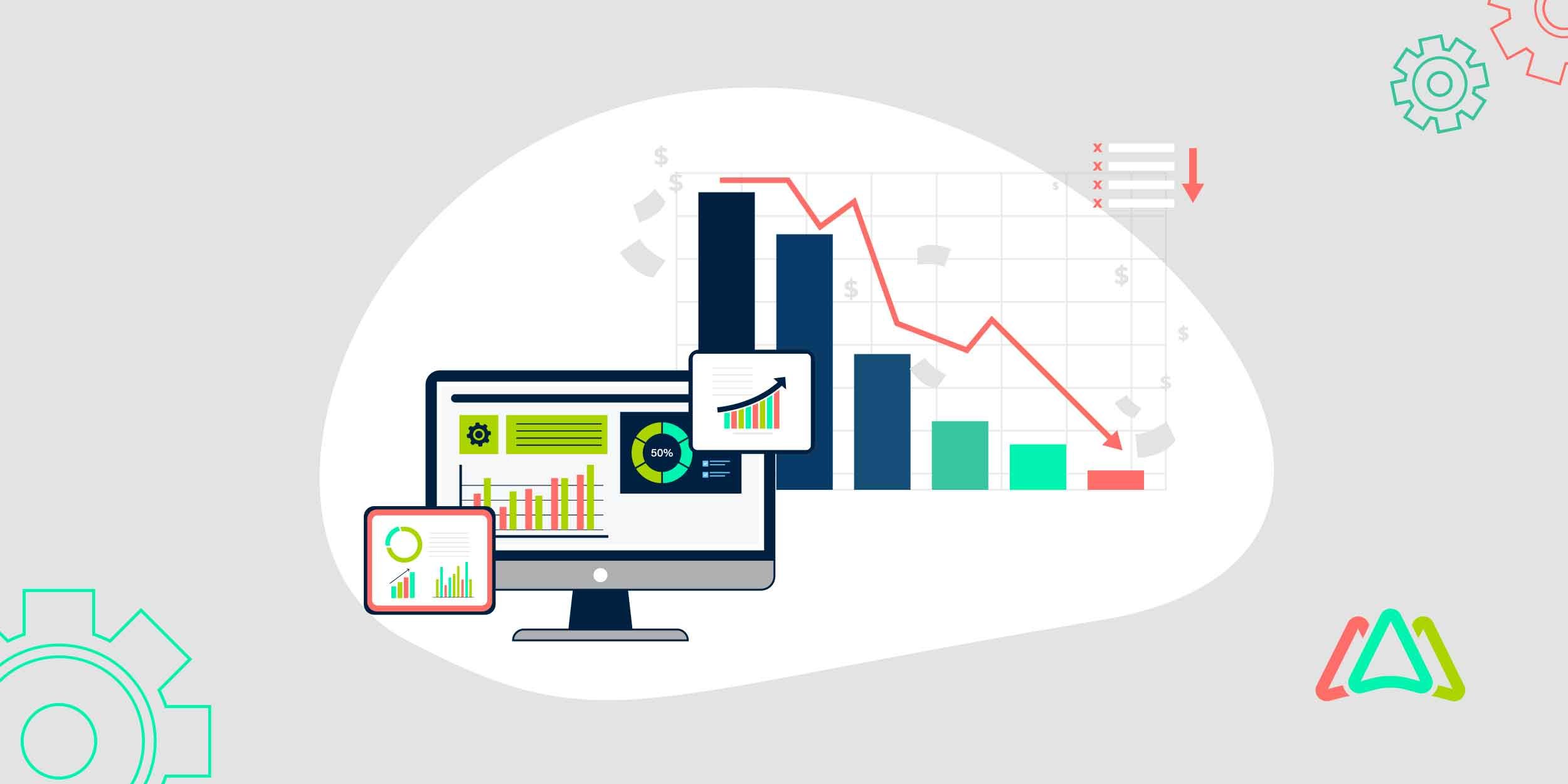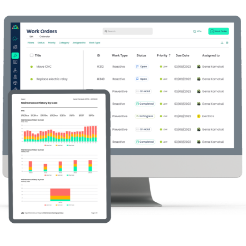
How CMMS Software Helps Organizations Manage Economic Volatility
Companies are subject to economic ups and downs, also known as economic volatility. Today, more than ever, this unpredictability has become the norm rather than the exception. Whether it’s fluctuating supply chain costs and labor shortages, or sudden market shifts and tightening budgets, organizations are under constant pressure to do more with less. Companies that are ill-equipped to address these uncertainties may find their maintenance departments crippled by costly downtime, inefficiencies, and missed opportunities for improvement. To survive in such an environment, adaptability and efficiency are key.
The challenges that come with economic volatility impact all organizational departments, including facilities and maintenance operations. This is where a Computerized Maintenance Management System (CMMS) comes in. The best CMMS software is designed to help organizations maintain control even when external factors are unstable. It does this by providing the structure and visibility needed to plan, prioritize, and optimize maintenance operations across assets and teams. More specifically, a CMMS enables maintenance leaders to make informed decisions quickly—protecting both productivity and profitability by automating work orders, tracking costs, and analyzing performance data. In a volatile economy, the right CMMS becomes a strategic investment in maintaining stability.
This article explores what attributes to look for in a CMMS to cope with economic uncertainties and volatility. We cap things off with a list of top CMMS providers to consider if your organization is looking to purchase a new CMMS to replace an existing platform or implement a new solution for the first time.
What Makes the Best CMMS Software During Economic Uncertainty
To effectively cope with economic volatility, maintenance teams must find ways to address reduced budgets, unpredictable supply costs, and increased pressure to keep operations running without disruption. Choosing the best CMMS software solution can make a difference by providing maintenance scheduling and, more importantly, by offering a holistic approach to asset management that helps organizations adapt to changing market conditions. To remain competitive and resilient, businesses need a CMMS that provides flexibility, scalability, and real-time insights into asset performance. Let’s take a closer look at specific CMMS features that define the best CMMS software.
Scalability and Flexibility
The best CMMS software is designed to grow and adapt with your organization. Scalability ensures that as operations expand—or contract—the software can handle changes in user volume, asset counts, and maintenance workload without compromising performance. For example, if a company acquires a new facility or temporarily reduces production, the CMMS should easily adjust to the latest maintenance requirements. Flexibility also means the system can be configured for different departments, workflows, and reporting needs without requiring complex customization. These features are essential in a volatile economy. During these times, companies may need to scale operations up or down quickly, and the software must adapt without requiring costly, time-consuming overhauls or new infrastructure. This adaptability allows businesses to maintain efficiency no matter how quickly the economic landscape shifts.
Cost-Efficiency and ROI
Economic uncertainty adds to the need for financial control. The best CMMS software helps organizations maximize value by reducing maintenance costs and minimizing asset downtime. By scheduling preventive and predictive maintenance, teams can address issues before they become costly failures. The most robust CMMSs have built-in tracking tools that capture labor hours, parts usage, and repair frequency, allowing managers to identify inefficiencies and optimize spending. Over time, this leads to better resource allocation and measurable returns on investment (ROI). In a volatile economy, the savings gained from improved asset reliability and reduced unplanned downtime directly impact the organization’s bottom line.

Cloud-Based Access and Mobility
In an era where maintenance teams are often spread across multiple sites—or even working remotely—cloud-based CMMS solutions are no longer a luxury; they’ve become a necessity. Cloud-based access and mobility enable users to securely access maintenance data in real time from any device—desktop, tablet, or mobile phone—so teams can stay connected regardless of location. This added flexibility ensures operations continue uninterrupted even during supply chain disruptions, staffing shortages, or shifts to remote work. Cloud hosting also eliminates the need for expensive on-premises servers and IT maintenance. The result is reduced overhead, time, and personnel —an added benefit during uncertain economic times. Finally, automatic updates keep the system secure and up to date, providing peace of mind during critical business continuity periods.
Integration Capabilities
No software operates in isolation, especially in modern, data-driven environments. The best CMMS software integrates effortlessly with other business systems such as ERP, IoT, Building Management Systems (BMS), and predictive maintenance tools. These integrations create a unified digital environment where information flows freely across departments—linking maintenance performance with financial planning, inventory control, and production operations. For example, IoT sensors can detect early signs of equipment failure and automatically generate work orders within the CMMS, preventing costly downtime and ensuring maintenance is performed only when necessary.
During periods of economic volatility, this level of connectivity becomes even more critical. Integrated systems eliminate information silos, enabling decision-makers to see the complete financial and operational picture in real time. When budgets are tight or supply chains are uncertain, this transparency helps organizations prioritize maintenance tasks, manage spare parts inventories more efficiently, and avoid unnecessary expenditures. In short, integration capabilities turn a CMMS from a standalone maintenance tool into a strategic mechanism—helping organizations respond faster, control costs, and maintain stability even when market conditions are otherwise.
Advanced Analytics and Reporting
Data is only valuable if it leads to useful insights. A robust CMMS is a system that includes advanced analytics and customizable reporting tools that transform raw maintenance data into actionable decision-making. With these capabilities, maintenance leaders can track key performance indicators (KPIs) such as mean time between failures (MTBF), mean time to repair (MTTR), and work order completion rates. On the other hand, predictive analytics can identify emerging trends and forecast future maintenance needs, helping organizations anticipate challenges rather than react to them. During volatile economic times, these insights allow decision-makers to make quick, evidence-based adjustments to schedules, budgets, and staffing.
User-Friendly Interface and Adoption
Even the most powerful CMMS is only as effective as the people who use it. A user-friendly interface makes widespread adoption possible by shortening the learning curve and simplifying daily workflows. The best CMMS software includes intuitive dashboards, visual work-order tracking, and drag-and-drop functionality, making it accessible to both technicians and managers. Built-in training resources, guided setup wizards, and mobile usability enhance the user experience. This ease of use ensures that teams can focus on maintaining assets—instead of figuring out complex software—something that is essential when staff turnover or reduced training budgets limit onboarding time.
Ultimately, what distinguishes the best CMMS software in a volatile economy is its ability to deliver clarity, control, and confidence. These platforms go beyond digitizing maintenance—they enable more thoughtful decisions, greater efficiency, and organizational resilience. By leveraging scalability, integration, analytics, and ease of use, businesses can transform uncertainty into opportunity, ensuring assets continue to perform at their best no matter what challenges the economy brings.
Choosing the Right CMMS for Your Organization
Selecting the best CMMS software goes beyond choosing the most feature-rich platform or the most recognizable brand name. It’s about finding a solution that fits with your organization’s size, industry, goals, and financial realities—especially during economic volatility. The ideal CMMS should not only solve current maintenance challenges but also scale and adapt to the uncertainties ahead. Making a thoughtful, data-informed selection can mean the difference between a system that drives measurable efficiency and one that becomes an underused expense.

Assess Your Maintenance Challenges and Priorities
Before even considering comparing software options, it’s essential to understand your current pain points and goals. For example, are equipment failures causing costly downtime? Is your team struggling with disorganized work orders or inefficient communication? Or are you looking to consolidate data across multiple sites? This is when you need to consider your needs for scalability and flexibility, integration capabilities, mobile access, and user adoption. By clearly defining your top challenges, you will narrow the field to solutions designed to address those specific needs. In an unpredictable economy, this clarity will prevent unnecessary spending on features that may sound impressive but don’t address your needs.
Once you’ve completed this critical step, you’ll be ready to move on to comparing the range of CMMS solutions available in the marketplace.
Analyze Vendor Support and Training
Reliable vendor support can make or break your CMMS implementation. Keep your eye out for providers that offer comprehensive onboarding, responsive technical assistance, and ongoing training resources. Many vendors provide dedicated customer success teams that help configure the system to your organization’s needs and guide users on best practices. During economic uncertainty, when teams are often operating with leaner staffing, dependable support helps you maximize the software’s value and minimize downtime caused by technical issues.
Review Pricing Models and Total Cost of Ownership
Price alone shouldn’t determine your choice—but it’s crucial to understand the complete financial picture. Compare subscription-based models versus perpetual licenses and review the features and services included in each pricing tier (such as mobile access, updates, or integrations). Be on the lookout for hidden costs, such as setup fees, additional user licenses, or training expenses. The goal is to ensure transparency so that the CMMS you choose aligns with your budget planning. Keep in mind, the best CMMS software solution is not necessarily the cheapest—it’s the one that delivers measurable efficiency gains and long-term ROI under both stable and unstable economic conditions.
Take Advantage of Demos and Free Trials
Most reputable CMMS vendors offer free trials or live demonstrations. Use this opportunity to evaluate not only the features but also the overall user experience and fit with your team’s workflows. Have actual users—technicians, supervisors, and managers—participate in testing, as they will provide valuable feedback on usability and practicality. This hands-on evaluation can reveal potential challenges before you commit financially. In an unpredictable economy, testing before buying is a prudent way to ensure your investment aligns with both your operational and financial goals now and in the future.
Ultimately, choosing the right CMMS software is about aligning technology with strategy. The right platform allows maintenance teams to operate efficiently, make informed decisions, and maintain control—no matter what the economy brings. By focusing on scalability, usability, and vendor partnership, organizations can invest confidently in a system that not only supports short-term goals but also lays the foundation for long-term resilience and growth.
If your organization is considering implementing a CMMS for the first time or looking to replace an existing software, check out these lists of top CMMS providers;
Conclusion
Economic volatility will always be a challenge, but it doesn’t have to be a barrier. Sometimes, uncertain times can reveal which organizations are truly built for resilience, with maintenance being the cornerstone of that strength. When budgets tighten and operations come under pressure, the companies that thrive are the ones that can do more with less, anticipate problems before they escalate, and make decisions grounded in reliable data. This is precisely where the best CMMS software proves invaluable.
By centralizing maintenance operations, automating tasks, and transforming data into actionable insights, a CMMS enables businesses to maintain control amid an unpredictable economy. These software systems reduce waste, optimize equipment performance, and improve resource allocation. Beyond short-term savings, a robust CMMS builds long-term stability—helping organizations extend asset life, manage energy use, and maintain compliance even when external conditions fluctuate.
In an economy characterized by rapid change, investing in the right CMMS is more than a cost-saving measure—it’s a strategic decision. The best CMMS software equips companies to predict, plan, and lead with confidence. Whether your goal is to improve uptime, cut operational costs, or build a more sustainable maintenance strategy, the right system turns uncertainty into opportunity.
TABLE OF CONTENTS
Keep Reading
Maintenance challenges are a constant struggle, with unplanned downtime costing manufacturers ...
27 Oct 2025
Last winter, a maintenance technician at a U.S. paper mill ignored a predictive alert that ...
10 Oct 2025
Many organizations proudly say they “have a CMMS,” but ownership alone doesn’t equal ...
9 Oct 2025
Every maintenance team is under pressure to do more with less. Unplanned downtime is often ...
7 Oct 2025
The implementation of simple, yet powerfully effective, checklists has repeatedly ...
3 Oct 2025
In manufacturing, every second counts. When production stops, whether due to scheduled ...
2 Oct 2025
The increasing cost of maintenance, lack of accountability, and siloed systems leave many ...
30 Sep 2025
Preventive maintenance is one of those things maintenance teams know they need to do, but it ...
26 Sep 2025
Public services are essential to daily life. The provision of safe roads, functional transit, ...
25 Sep 2025
For most manufacturing facilities, a major focus of their maintenance teams revolves around ...
24 Sep 2025
Have you ever tried explaining to the CEO why the production line has been down for hours ...
18 Sep 2025
Over the past few decades, the hotel industry has undergone a dramatic transformation. ...
16 Sep 2025
Profitability is at the top of the list for manufacturing organizations when conversations ...
12 Sep 2025
Lean manufacturing is a goal that organizations strive for in their quest for operational ...
11 Sep 2025
In many organizations, the primary focus of maintenance work is on completing work orders, ...
9 Sep 2025
Word order backlogs are a reality that all maintenance and facilities management teams face. ...
5 Sep 2025
The critical nature of medical equipment has made maintenance management in healthcare ...
4 Sep 2025
Work orders are the lifeblood of maintenance; they help maintain organization, ensure ...
2 Sep 2025
The world of IoT is growing rapidly in almost every aspect of life across a variety of ...
29 Aug 2025
The adoption of Computerized Maintenance Management Systems (CMMS) presents a puzzling ...
28 Aug 2025





